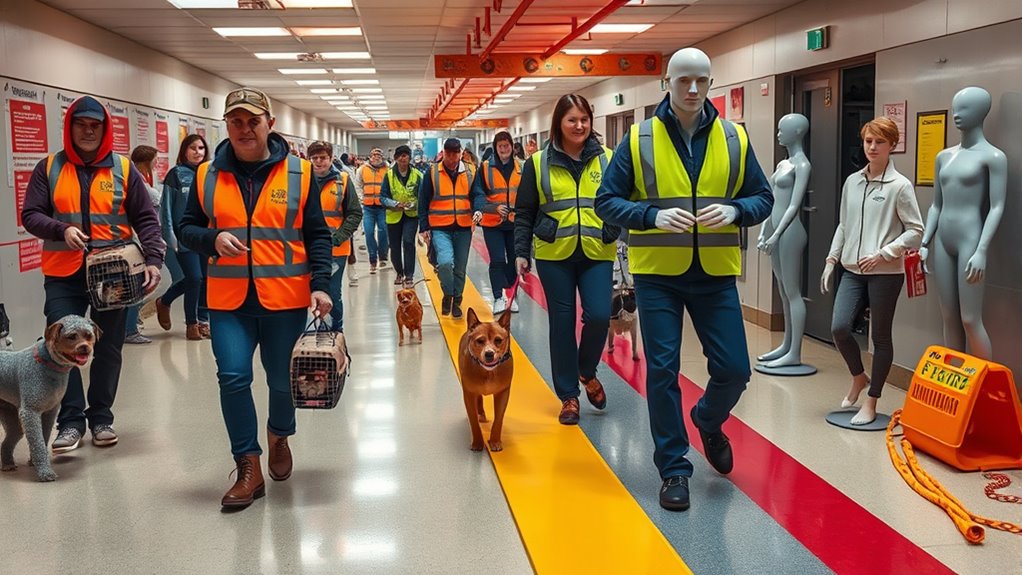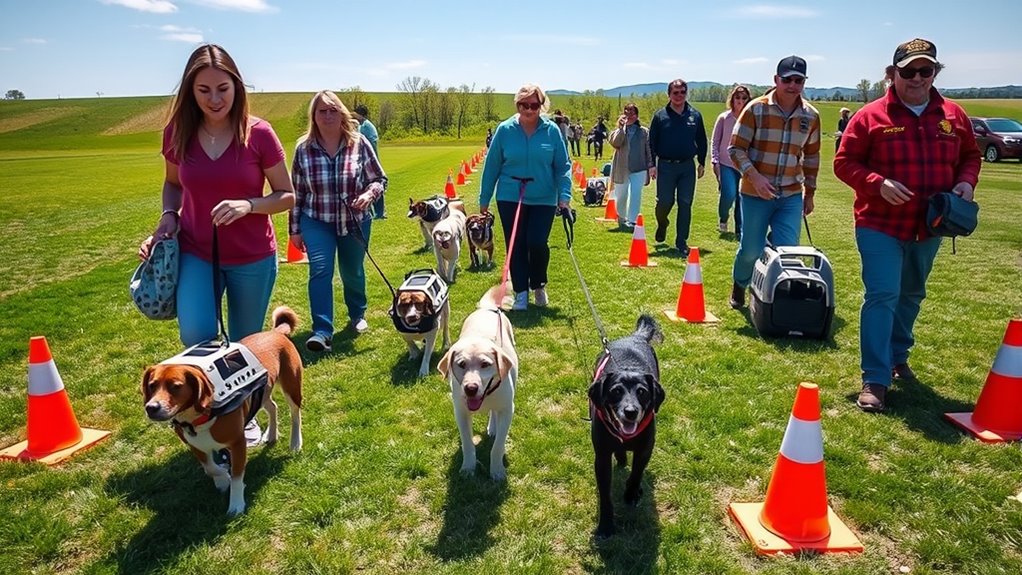To run evacuation drills with pets, start by introducing them steadily to their emergency kit using treats and positive reinforcement. Practice calling them to their crates, guiding them inside calmly, and rewarding compliance. Incorporate commands like “stay” and “leave it” to build responsiveness. Keep training sessions short, consistent, and positive to reduce anxiety. If you keep practicing these steps, you’ll discover even more ways to guarantee your pet’s safety during emergencies.
Key Takeaways
- Develop clear, step-by-step training scripts that simulate real evacuation scenarios with commands and responses.
- Gradually introduce pets to their emergency kit using positive reinforcement and familiarization exercises.
- Practice guiding pets into crates or carriers calmly, rewarding compliance to build confidence.
- Incorporate specific commands like “crate,” “stay,” and “leave it” during drills to ensure responsiveness.
- Keep training sessions short, consistent, and positive to reduce stress and improve pet cooperation during emergencies.

Evacuation drills are essential for ensuring safety during emergencies, but many pet owners overlook the importance of including their furry friends in these plans. When you neglect to incorporate your pet into your emergency planning, you risk putting their safety at significant risk. Properly training your pet for evacuation scenarios helps ensure they remain calm, responsive, and safe when it’s time to leave your home quickly. Developing clear, consistent training scripts for evacuation drills can make all the difference in how your pet responds during a real emergency.
Start by familiarizing your pet with their emergency kit. Use positive reinforcement and treats to reward them when they approach or touch their crate or carrier. This step helps your pet associate these items with comfort rather than fear. Once your pet is comfortable with their crate, practice placing them inside calmly. Repetition is key—run short sessions regularly so they become accustomed to being confined, which is often necessary during emergencies. When your pet willingly enters their crate, praise them enthusiastically, reinforcing positive behavior.
Next, simulate the act of evacuating your home. Call your pet to their crate, then gently guide them in and close the door. Use a command like “crate time” or “let’s go,” and always reward compliance. Practice carrying your pet to the designated evacuation area, whether that’s a neighbor’s house, your car, or a safe outdoor spot. Keep these sessions brief and positive, gradually increasing the duration as your pet becomes more comfortable. Throughout this process, stay calm and reassuring—your demeanor influences your pet’s response.
Incorporate training scripts that include specific commands for emergency situations, such as “stay,” “leave it,” or “heel.” These commands can help control your pet’s behavior during a frantic evacuation. Practice these commands regularly during your drills, rewarding your pet for obeying promptly. If your pet tends to panic or become anxious, work on desensitization techniques, such as exposing them to loud noises or sudden movements in a controlled environment. The goal is to keep pet safety at the forefront of your emergency planning, ensuring your pet remains as calm and cooperative as possible.
Additionally, understanding air purifier maintenance can help create a healthier environment for your pet, especially during stressful times or if they are sensitive to airborne allergens. Review and refine your training scripts based on your pet’s progress. Repetition, patience, and positive reinforcement build confidence in your pet, making evacuation drills more effective. When you include your furry friend in your emergency planning with thoughtful training scripts, you’re better prepared to protect their safety during an actual crisis. This proactive approach not only fosters a sense of security for your pet but also ensures you’re ready to act swiftly and efficiently, minimizing stress and confusion when it matters most.
Frequently Asked Questions
How Can I Include a Nervous Pet in Evacuation Drills?
To include a nervous pet in evacuation drills, start with behavior modification by gradually exposing them to the process. Use calming techniques like treats and gentle praise to reduce anxiety. Practice short, positive sessions, then increase duration as your pet becomes more comfortable. Keep a calm tone and stay patient. Repeating these steps helps your pet associate drills with safety, easing their nervousness over time.
What Supplies Should I Prepare for Pets During an Emergency?
You should prepare emergency pet supplies and pet travel gear for your pet during an emergency. Pack essentials like food, water, medications, and a first aid kit. Include a sturdy carrier, leash, and extra blankets to keep your pet comfortable. Don’t forget to bring important documents like vaccination records. Having these supplies prepared guarantees you can evacuate quickly and keep your pet safe and calm in any emergency situation.
How Do I Train My Pet to Respond to Evacuation Commands?
Imagine the fear in your pet’s eyes during an emergency. To prevent that, train them to respond instantly to emergency cues using pet obedience techniques. Start with short, consistent sessions, rewarding calm behavior. Use clear commands like “come” or “leave it” during simulated evacuations. Repeat often, gradually increasing the distraction level. When real danger strikes, your pet will trust your cues, keeping them safe and reducing chaos.
What Are Common Mistakes to Avoid During Pet Evacuation Drills?
During pet evacuation drills, avoid common mistakes that compromise household safety and emergency planning. Don’t forget to include your pet in the plan, guaranteeing they’re familiar with commands and routes. Avoid rushing or panicking, as it can stress your pet. Never leave your pet behind or unprepared. Practice regularly to build confidence, and always keep emergency supplies handy. Staying calm and prepared helps ensure a safe, smooth evacuation for everyone involved.
How Often Should I Practice Evacuation Drills With My Pets?
You should practice evacuation drills with your pets at least twice a year. Studies show that regular training improves response times and reduces panic in emergencies. During drills, focus on evacuation route planning and use pet identification methods like tags or microchips. Frequent practice helps your pets become familiar with procedures, making actual evacuations less stressful and more successful for both of you.
Conclusion
Practicing evacuation drills with your pets prepares you both for emergencies, making the process smoother and less stressful. Think of it as a dance where every step is familiar, and you move in harmony. By rehearsing regularly, you guarantee your furry friend stays safe and calm when seconds count. Remember, preparation is your best tool in a crisis—so stay proactive, stay confident, and keep practicing together for peace of mind when it matters most.










